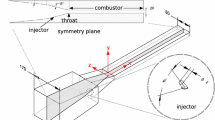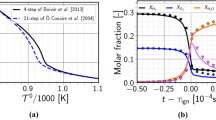Abstract
The attainment of satisfactory supersonic combustion requires that the fuel and air be mixed to a sufficient extent at the molecular level, at a high enough temperature, so that the combustion reaction is largely complete before the gases leave the combustor. The macro-mixing must be achieved through turbulence, and molecular diffusion effects are only significant within the dimensions of the viscous eddies. The effects of macro-mixing only extend for the dimensions of the macro-scale eddies, hence the fuel injectors must be separated by a distance not exceeding twice the macro-scale. Since the turbulence is produced at the expense of the kinetic energy of the flow, there is an engine thrust penalty as the level of turbulence is increased. On the other hand, combustion efficiency and therefore thrust is limited by the degree of mixing. Hence there is an optimum level of turbulence, mixing and combustion efficiency in a scramjet engine.
The design of practical supersonic combustors entails arranging the geometry so that this optimum can be achieved. Various systems have been investigated experimentally at Sheffield University and it should be noted that interaction between the pressure gradients due to heat release and the flow must be taken into account since there may be large differences between the flows with and without combustion. Thus calculation procedures are required to accurately predict the supersonic (or mixed supersonic-subsonic) turbulent reacting flows. One of the most successful practical geometries which we have tested involves the generation of vortices within the flow by injectors spanning the stream, with their trailing edges swept back behind the local Mach angle. These produce multiple vortices within the flow, and in common with other vortex flows will have turbulence which is highly anisotropic. We have already developed a very successful Reynolds stress code for subsonic swirling flow calculations and this technique may be extended to supersonic flows.
(NB Parts of this paper were covered in Ref. 10. However, since that document is of very limited availability, is was considered that its inclusion here would be helpful).
Access this chapter
Tax calculation will be finalised at checkout
Purchases are for personal use only
Preview
Unable to display preview. Download preview PDF.
Similar content being viewed by others
Abbreviations
- A, B:
-
constants
- D:
-
dissipation
- h:
-
static enthalpy
- I:
-
specifiC impulse
- K.E.:
-
kinetic energy
- KEdef :
-
wake K.E. deficit
- Kd :
-
process efficiency
- le :
-
average size of energy containing eddies
- M:
-
Mach number
- nc :
-
combustion efficiency
- nm :
-
mixing efficiency
- nd :
-
kinetic energy of diffuser
- p:
-
static pressure
- P:
-
total pressure
- Q:
-
heat release rate
- q:
-
ρU2/2
- ρ:
-
density
- T:
-
temperature
- τs :
-
reactor stay time
- τd :
-
diffusion time
- u’:
-
r.m.s. turbulence velocity
- U:
-
mean velocity
- W:
-
mass flow rate
- X:
-
reactor volume
- λ:
-
characteristic dimension
- Ψ:
-
fraction of oxygen unreacted
References
Swithenbank, J. and Chigier, N.A. “Vortex Mixing for Supersonic Combustion”, 12th Int. Symp. on Combn., 1969 pp. 1153–1162.
Swithenbank, J., “Hypersonic Air Breathing Propulsion”, Prog. in Aeronautical Sci., Vol. 8, ed. D. Kuchemann, Pergamon Press, 1967.
Curran, E.T. and Swithenbank, J. “Really High Speed Propulsion by Scramjets”, Aircraft Engineering, Jan., 1966.
Swithenbank, J., “Combustion Fundamentals”, Dept. of Chem. Eng., Sheffield Univ., Report H.I.C. 150.
Swithenbank, J., “Flame Stabilization in High Velocity Flow”, COMBUSTION TECHNOLOGY Ed. Palmer and Beer, pp 91–127, Academic Press, 1974.
Hinze, J.O., “Turbulence”, McGraw Hill, 1959.
Hoerner, S.F., “Fluid Dynamic Drag”, Published by Author, 1958.
Schlichting, H., “Boundary Layer Theory”, McGraw Hill, 1968.
Rues, D., “Concerning the Equivalence between Heat, Force and Mass Sources”, R.A.E. Library Translation No. 1119, July 1965.
Swithenbank, J., Jaques, M. T., and Payne, R. “The Role of Turbulence in Scramjet Combustor Design” Proceedings of the 1st International Symposium on Air Breathing Engines, Marseilles, June 1972.
Editor information
Editors and Affiliations
Rights and permissions
Copyright information
© 1989 Springer-Verlag New York Inc.
About this paper
Cite this paper
Swithenbank, J., Boysan, F., Ewan, B.C.R., Shao, L., Yang, Z.Y. (1989). Mixing Problems in Supersonic Combustion. In: Borghi, R., Murthy, S.N.B. (eds) Turbulent Reactive Flows. Lecture Notes in Engineering, vol 40. Springer, New York, NY. https://doi.org/10.1007/978-1-4613-9631-4_40
Download citation
DOI: https://doi.org/10.1007/978-1-4613-9631-4_40
Publisher Name: Springer, New York, NY
Print ISBN: 978-0-387-96887-2
Online ISBN: 978-1-4613-9631-4
eBook Packages: Springer Book Archive




